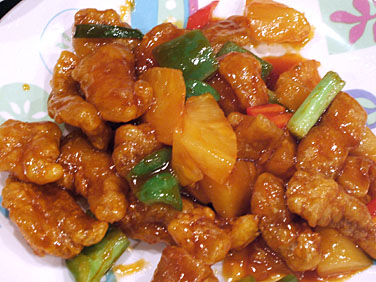 Chinese food from takeaways is not only full of delicious flavours – it can be a healthy option too. If you're eating in a Chinese restaurant, buying from a takeaway or cooking at home, remember to go for lower-fat options.
Chinese food from takeaways is not only full of delicious flavours – it can be a healthy option too. If you're eating in a Chinese restaurant, buying from a takeaway or cooking at home, remember to go for lower-fat options.
You could choose dishes such as steamed fish, chicken chop suey and Szechwan prawns. Lower-fat options include anything boiled or steamed, such as steamed fish and plain rather than fried rice. And for a healthy choice, it's best to avoid anything in batter because these foods are high in fat.
Steaming rather than deep-fat frying really cuts down on fat. Traditionally, Chinese food was cooked in small bamboo steamers, but it's easy to steam food if you're cooking at home. If you haven't got a steamer, try putting the food in a sieve over a pan of boiling water. The great thing about steaming is that you don't need to add any fat, and steamed vegetables keep their natural flavour and nutrients.
Stir-frying, another traditional Chinese cooking method, can also be a healthy way to cook. Ideally you should use a wok, but any large pan will do. You only need to use a very small amount of oil and the food cooks quickly. This means the food is low in added fat and it retains more nutrients because the cooking time is shorter. So, if you're cooking up your own stir-fry, you'll end up with a meal that's tasty, nutritious, ready quickly, and you'll only have one pan to wash!
Stir-fries typically contain a good selection of vegetables and a moderate amount of lean meat or other protein, and they're usually served with a large portion of rice or noodles – which is a great combination for a healthy diet.
A healthy balanced meal should be based around starchy foods, so for a Chinese meal choose foods such as rice, noodles, dumplings, plain and vegetable buns, and go for wholemeal or wholegrain versions whenever possible. These foods are filling, but they're not fattening unless they're cooked with oil, or you add fatty spreads and sauces to them. So choose boiled or steamed versions instead of frying, if possible.
We should be eating lots of fruit and vegetables. The aim is to have at least five portions of a variety of fruit and vegetables each day. So choose from the following Chinese delights: bamboo shoots, bean sprouts, chinese cabbage/greens such as pak choi, water chestnuts, baby corn, exotic varieties of mushrooms and onions, aubergine, lychees, mandarins, melon, starfruit, and the list goes on.
We need to eat moderate amounts of protein such as duck, chicken, squid, prawns, bean curd (tofu), eggs and nuts. For a healthy choice, go for the lower-fat versions whenever possible. Choose lean meat, trim off any excess fat and skim the fat off the top of meat soups.
We should also have moderate amounts of milk and dairy foods, but these foods don't feature heavily in traditional Chinese cuisine, so you could choose fortified soya or rice milk, fish where you eat the bones, green leafy vegetables and tofu as alternative sources of calcium.
Only eat foods containing fat and/or sugar sparingly. So, when you're cooking, use as little oil as possible. Instead of sugary desserts or snacks try porridge, noodles, steamed dumplings and fruit. Drink milk, water, herbal teas and fruit juice instead of sugary drinks. And why not try a pot of jasmine tea after your meal and some lychees for dessert?
Chinese seasonings and sauces make food tasty but they're high in salt, so only use these in moderation:
* hoisin (barbecue) sauce
* plum sauce
* black/yellow bean sauces
* soy/oyster/fish sauces
You could try these flavourings instead: pepper, ginger, garlic, five-spice powder (star anise, fennel, clove, cinnamon, peppercorns).
Also, you may have heard that some soy sauces contain unhealthy processing chemicals. But levels of these chemicals (called 3-MCPD) are coming down. In fact, when the Agency checked samples of soy sauce in 2001, nearly a quarter had 'higher than acceptable' levels, but only 6% did in 2002. This is because more and more companies have recognised the problem and are working to avoid it. Even at these higher levels, you would need to have a lot of soy sauce with higher than acceptable levels of these chemicals, and eat it regularly for many years for there to be a health risk from the chemicals.
There are plenty Chinese food takeaways to choose from in UK. Takeaways in Balham, takeaways in Leyton and food takeaways in Reading.